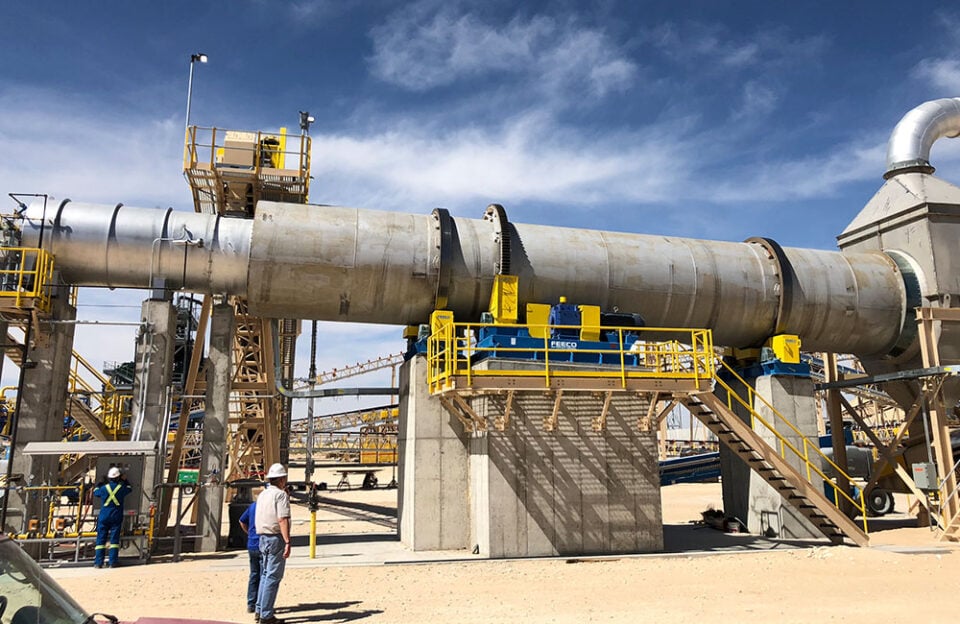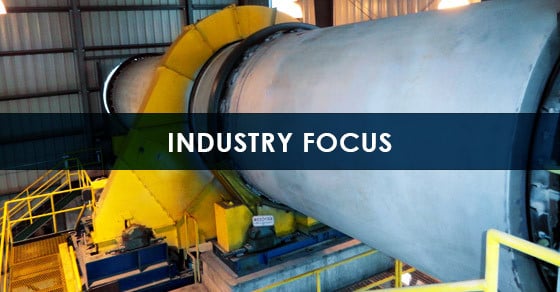Sand dryers play a pivotal role in preparing industrial sands for market, ensuring they meet the precise chemical and physical specifications required across a variety of industries. These sands are used in everything from electronics to paint, making consistent quality essential.
A key factor in achieving this quality is moisture content. By reducing moisture to the appropriate level, the sand dryer helps ensure the material performs as needed in its end-use application.
Applications That Demand a Sand Dryer
Industrial sands such as garnet and silica go through a myriad of processing stages upon mining in order to clean and refine the sand for its intended use. While this process varies depending on the end product, most applications require sand to be washed and dried.

Rotary dryer for frac sand
Washing serves to remove impurities and ensure a premium product suitable for market, while maximizing the amount of saleable product obtained. Following washing, sand must be dried.
Drying not only reduces the moisture content, improving the economics of shipping, but it is often a requirement of the application in which it will be used, with each application requiring its own specific parameters.
Common applications in which industrial sands require a specific moisture content include:
Glass
In glass production, moisture must be carefully balanced so that it is not too high or too low; if the level of moisture is too high, additional energy is required due to elevated melt temperatures and greater production times; if the moisture content is reduced too far, however, excessive dust is likely to occur in the furnace, which will impact product quality.
Abrasives
Sand is a widely used abrasive. In blasting applications, moisture content must fall below 0.5% by weight. A higher moisture content will result in flow problems.1
Foundry Sand
Moisture content plays a critical role in the foundry sands used in metal casting applications, affecting parameters such as refractoriness, flowability, chemical inertness, and several other factors. Managing these properties is crucial to avoiding defects in the casting.2
Hydraulic Fracturing (Proppants)
While the hydraulic fracturing market in the US has died down, it is still going strong in other areas of the world. Here, industrial sand, called frac sand in this case, serves as a proppant, or a material that holds open rock fissures to allow hydrocarbons to flow out. Here, frac sand must not exceed a certain moisture threshold for use as a proppant.
Additional Sand Applications
In addition to the applications above, industrial sands are employed in a host of other applications with their own specifications as well. This includes:
- Chemical production
- Construction and building materials (ex., dry mortar sands)
- Paints and coatings
- Filter media
- Ceramics
Characteristics of a Sand Dryer
Sand dryers must be designed to meet the precise moisture content of the intended application. In addition to this, industrial sand processing, like any industry, has a few specific requirements when it comes to drying equipment:
High Capacity
The nature of industrial sand processing operations typically demands a high-throughput sand dryer.
Resistant to Abrasion
Not surprisingly, dryers destined for processing sand must be designed with sand’s abrasive characteristics in mind. Depending on how abrasive the specific source of sand is, this may necessitate the use of abrasion-resistant steel, higher shell thicknesses, and the reinforcement of high-wear areas.
Minimal Carryover
Carryover occurs when sand particles become entrained in the air flow, causing them to leave the unit through the exhaust gas handling system. Not only does this result in lost product, but it also reduces dryer efficiency. Sand dryers must be designed to find a balance between maximum throughput and minimal carryover.
Maintains Product Integrity
In many cases, the desired quality of the end product will require the use of a combustion chamber in order to preserve product integrity. A combustion chamber prevents the burner flame from coming into contact with the sand, preventing undesirable reactions that could otherwise result in a degraded product.
Which Sand Dryer is Best: Rotary Drum or Fluid Bed?
Whether drying sand for use as an abrasive,in the glass manufacturing process, or otherwise, sand producers are often confronted with the decision of choosing between the rotary dryer and the fluid bed dryer.
While fluid bed dryers are still commonly used, rotary drum dryers have become the industry’s preferred choice in most cases. This is because their robust construction is well suited to handling the demanding processing conditions characteristic of the industry.
Additionally, rotary drum dryers not only accommodate a higher throughput than fluid bed dryers, but they also use comparatively less electrical energy, requiring a lower volume of air, and unlike fluid beds, offering further energy savings when running at a reduced capacity.
Rotary dryers are also favored for their ability to produce uniform drying results despite variation in feedstock and processing conditions.
Conclusion
Industrial sands bring modern society many of the products and materials we rely on throughout our daily lives. Sand dryers, and rotary drum dryers in particular, play a key role in helping to produce sand suited to the unique specifications of its intended application, but must be designed with sand’s characteristics in mind.
FEECO is a preferred provider of custom rotary drum dryers. All FEECO sand dryers are designed around the specific characteristics and goals of the intended product for an optimized drying solution that not only performs reliably, but stands the test of time. For more information on our sand dryers, contact us today!

